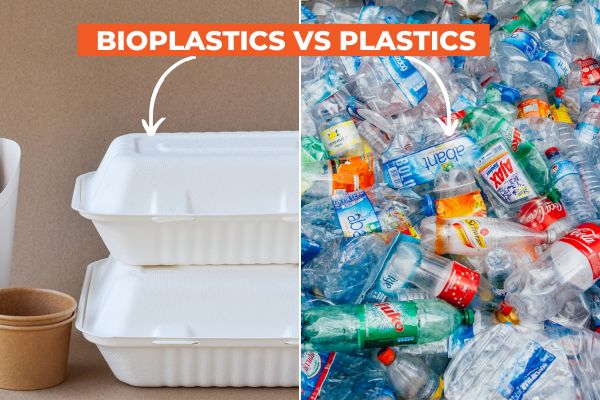Pros and Cons of Bioplastics vs Plastics
Bioplastics and regular plastics differ significantly in their composition, production process, environmental impact, and end-of-life characteristics. Below we take a look at the differences of bioplastics vs plastics.
Bioplastic
Bioplastics are derived from renewable biomass sources such as plants, algae, or organic waste. Common feedstocks for bioplastics include corn starch, sugarcane, cellulose, and vegetable oils. Common types of bioplastics include PLA (Polylactic Acid), PBS (Polybutylene Succinate), and PHA (Polyhydroxyalkanoates).
Production Process:
Initially, biomass feedstocks are cultivated or harvested and processed to extract raw materials such as sugars, starches, or oils. These raw materials are then converted into monomers through fermentation, enzymatic reactions, or chemical synthesis. Next, the monomers undergo polymerization to form bioplastic polymers, which can be further processed and modified to achieve the desired properties. This generally requires lower energy inputs compared to fossil fuel-based plastics.
Environmental Impacts:
Bioplastics are often promoted as a more sustainable alternative to regular plastics due to their renewable origins and potential for biodegradability. However, the environmental impact depends on various factors, including the source of the feedstock, the production process, and end-of-life management.
End-of-Life Characteristics:
Bioplastics can be either biodegradable or non-biodegradable, depending on their composition. Biodegradable bioplastics have the potential to break down into natural elements such as water, carbon dioxide, and organic matter under certain conditions, such as composting or microbial activity. Non-biodegradable bioplastics may still offer benefits such as reduced reliance on fossil fuels but may persist in the environment if not managed properly.
Summary:
- Renewable resources
- Can use waste materials
- Most are biodegradable
- Reduce fossil fuel consumption
- Reduced greenhouse gas emissions
- May compete with land for food production
- Limited applications
- Variable biodegradability
- Encourage the use of single-use items
Regular Plastic
Regular plastics, also known as traditional or conventional plastics, are derived from petrochemicals sourced from fossil fuels, such as crude oil or natural gas. The most common types of regular plastics include polyethylene (PE), polypropylene (PP), polyvinyl chloride (PVC), and polystyrene (PS).
Production Process:
The extraction and production of fossil fuel-based plastics involve extracted, transportation to refineries or petrochemical plants, and production through complex processes such as distillation, cracking, and polymerization, followed by further processing to enhance properties before it’s molded or extruded into finished plastic products. This requires significant energy use and leads to greenhouse gas emissions, resource depletion, and pollution.
Environmental Impacts:
Regular plastics have significant environmental drawbacks, including dependence on finite fossil fuel resources, contribution to greenhouse gas emissions, and persistence in the environment for hundreds or even thousands of years.
End-of-Life Characteristics:
Regular plastics are generally non-biodegradable and can persist in the environment for long periods without breaking down. This can lead to pollution of ecosystems, harm to wildlife, and accumulation of plastic waste in landfills, oceans, and other natural environments. These issues are already apparent across the globe.
Summary:
- Versatile
- Durable
- Recyclable
- Low-cost
- Widely Available
- Non-renewable/ finite resource
- Do not biodegrade
- Environmental Impacts
- Health concerns
- Harmful chemicals
In summary, both traditional plastics and bioplastics have their advantages and drawbacks, and the choice between them depends on factors such as application requirements, environmental considerations, and sustainability goals. While bioplastics offer the potential to reduce reliance on fossil fuels and mitigate environmental impacts, further research and development are needed to address challenges such as limited durability, competition with food production, and variable biodegradability.
Unfortunately, the answer is never simple!
Sources
- Bioplastics vs plastics: What’s better for the environment?
- State of the Planet, Renée Cho, The Truth About Bioplastics














